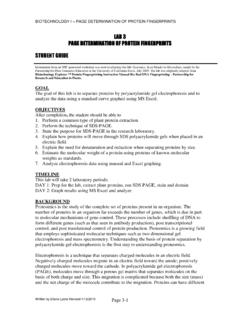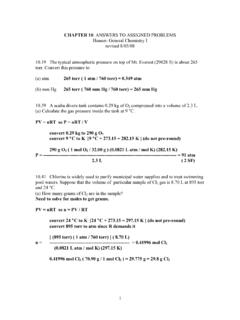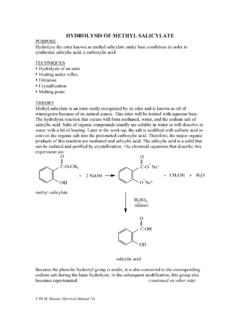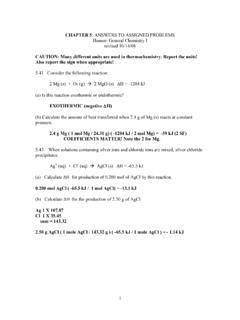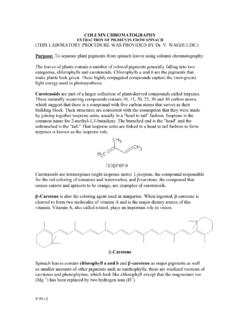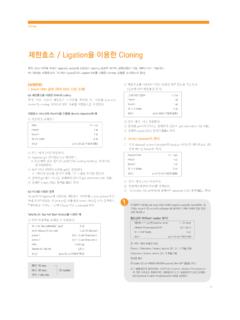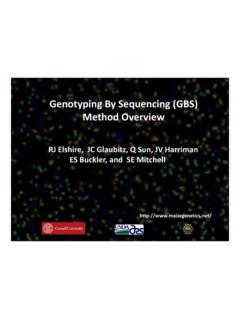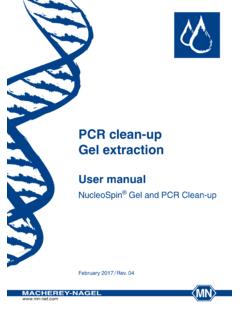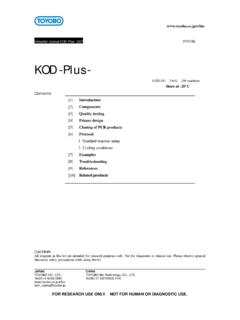Transcription of LAB 11 PLASMID DNA MINIPREP STUDENT GUIDE - …
1 BIOTECHNOLOGY I PLASMID DNA MINIPREP Eilene Lyons Revised June 14, 2007 Page 11-1 LAB 11 PLASMID DNA MINIPREP STUDENT GUIDE GOAL The objective of this lab is to perform extraction of PLASMID DNA and analyze the results. OBJECTIVES After completion, the STUDENT should be able to: 1. Perform a PLASMID DNA MINIPREP . 2. List the function of each solution used in a PLASMID DNA MINIPREP . 3. Verify the success of a PLASMID DNA MINIPREP using gel electrophoresis. 4. Identify the various conformations of uncut PLASMID DNA as seen in gel electrophoresis. 5. Estimate the size and concentration of PLASMID DNA using gel electrophoresis results. BACKGROUND MINIPREP Solutions and their Functions The MINIPREP process begins with the inoculation of liquid growth media with bacteria that contain PLASMID DNA. After overnight growth, an aliquot is removed and rinsed free of L-broth with Resuspension Solution. Cell Lysis Solution, which contains sodium dodecyl sulfate (SDS) and sodium hydroxide, is then added.
2 SDS is a detergent that dissolves phospholipid membranes leading to the lysis of the bacterial cell wall. The sodium hydroxide raises the pH, which not only denatures cell proteins, but also denatures DNA to single strands and degrades high molecular weight RNA. However, the circular PLASMID DNA remains supercoiled because the intertwined strands stay together, thus keeping them in solution rather than being tangled with the other larger denatured molecules present. Neutralization Solution, containing potassium acetate, is then added to neutralize the pH so the DNA renatures while the SDS precipitates, taking proteins and lipids with it. The chromosomal DNA also precipitates because it is attached at several sites to cell membrane proteins. A spin in the centrifuge separates most of the precipitated molecules from the PLASMID DNA still in solution. If the DNA is destined for restriction enzyme digestion, it must be cleaned further because contaminating proteins that remain will interfere with cutting.
3 In this lab, DNA Purification Resin is added to bind the DNA but not the protein and other cellular debris. Proteins and other contaminants are separated from the DNA+Resin by centrifugation. The PLASMID DNA clings to the resin as Column Wash Solution is added to carry off more of the cellular debris. After a spin to remove the wash solution, the DNA is eluted from the resin in molecular grade water. Sometimes TE buffer is used to elute DNA. TE is a mild preservative that contains 10 parts Tris buffer with one part EDTA (disodium ethylene diaminetetra-acetate2 H2O), which chelates Mg++ ions. (DNA degrading nucleases require cations to function properly.) TE buffer may also contain RNase, an enzyme that BIOTECHNOLOGY I PLASMID DNA MINIPREP Eilene Lyons Revised June 14, 2007 Page 11-2 degrades RNA but is not specific for DNA. When RNase is present, the RNA smear at the end of the sample run on the agarose gel will be absent. SAFETY GUIDELINES Ethidium bromide is a strong mutagen.
4 Gloves must always be worn when handling gels or buffers containing this chemical. The electric current in a gel electrophoresis chamber is extremely dangerous. Never remove a lid or touch the buffer once the power is turned on. Make sure the counter where the gel is being run is dry. UV light, used to illuminate the DNA stained with ethidium bromide, is dangerous. Eye protection must be used. MATERIALS MINIPREP Tubes of E. coli cultures Ice in ice bucket Vortex mixers automatic micropipetters and tips used tip container gloves Kim wipes ml microcentrifuge tubes Eppendorf microcentrifuge 10% bleach for disinfecting microfuge tube rack Sharpie marking pen Promega Wizard MINIPREP DNA isolation kit components TE Buffer containers to dispose of bacterial waste orange biohazard waste bag Gel Electrophoresis E-Gels and rigs Molecular Weight marker DNA ddH2O automatic micropipetters and tips used tip container gloves Kim wipes ml microcentrifuge tubes microfuge tube rack Sharpie marking pen UV Transilluminator UV Camera and film UV safety goggles and face shields metric ruler BIOTECHNOLOGY I PLASMID DNA MINIPREP Eilene Lyons Revised 1/12/2010 11-3 PROCEDURE NOTE: Personal microcentrifuges should NOT be used for PLASMID minipreps as they may not spin fast enough to produce good results.
5 PROCEDURE 1. Gently vortex the E. coli culture to resuspend cells. Transfer ~ ml of cells to a microcentrifuge tube and close tightly. (Use a separate tube for each culture.) 2. Centrifuge for 1 minute in a balanced microcentrifuge at full speed (12-13,000 rpm). 3. Decant all broth (but not the pellet) into a beaker for cell waste. Fill the same tube with another ml of the culture. (Cell waste will be autoclaved.) 4. Centrifuge for 1 minute in balanced microcentrifuge at full speed (12-13,000 rpm). 5. Decant all broth. Use a pipetter to remove any remaining liquid, leaving the cell pellet intact in the bottom of tube. 6. Add 200 l of Cell Resuspension Solution to the tube and VORTEX VIGOROUSLY to resuspend the cells. Turn the tube upside down and flick with your finger to spread the cell suspension along the walls of the tube - there should be no sign of the pellet or clumps of cells, only a homogeneous suspension. If there are clumps, vortex again. 7. Add 200 l of Cell Lysis Solution.
6 Cap the tube and invert GENTLY 3-4 times only. (Too much agitation may result in the chromosomal DNA breaking free of the protein debris, resulting in its co-purification with the PLASMID DNA). Opening the lid should expose a viscous, sticky solution. Each Team should have the following before beginning: 1. Fresh E. coli cultures of transformed cells 2. Cell Resuspension Solution 3. Cell Lysis Solution 4. Neutralization Solution 5. DNA Purification Resin 6. Column Wash Solution 7. One syringe per MINIPREP 8. One mini spin column per MINIPREP 9. Q-water 10. A beaker for cell waste BIOTECHNOLOGY I PLASMID DNA MINIPREP Eilene Lyons Revised 1/12/2010 11-4 8. Add 200 l of Neutralization Solution. Cap and invert GENTLY 3-4 times only. A white flocculent precipitate should be visible. 9. Centrifuge the tube at full speed for 5 minutes. (While waiting, prepare the column(s) see next step.) After centrifugation, there should be a tight white pellet with a clear supernatant.
7 10. To prepare a column, remove the plunger from a 3-ml disposable syringe, and set aside. Attach the syringe barrel to the Luer-Lok extension of the minicolumn. 11. Thoroughly mix the DNA Purification Resin. Add ml of the resuspended resin to the syringe barrel. 12. Without disturbing the pellet, carefully pour the supernatant from step 9 into the syringe barrel or transfer the supernatant with a pipette. DO NOT TAP THE TUBES. Dislodging the pellet or taking supernatant sitting on the pellet itself could result in contamination of PLASMID DNA with protein. Cap the tube containing the pellet and discard as biological waste. 13. Carefully insert the plunger into the syringe barrel and gently push the slurry into the minicolumn. Discard the solution that flows through the column. 14. Remove the syringe from the minicolumn. Remove the plunger from the syringe. 15. Attach the empty syringe barrel to the minicolumn again. 16. Add ml of Column Wash Solution to the syringe barrel.
8 Insert the plunger. Gently push the Column Wash Solution through the minicolumn. Discard the solution that flows through the column. 17. Remove and discard the syringe. Place the minicolumn into a microcentrifuge tube from which the cap has been cut off. Centrifuge at full speed for 2 minutes to dry the resin. Remove the minicolumn from the tube. Discard the tube and liquid. 18. Transfer the minicolumn to a new, labeled microcentrifuge tube (with no cap). Add 50 l of Q-water to the minicolumn. Avoid getting air bubbles between the resin and the water; place your pipette tip against the inner wall of the minicolumn before slowly expelling the water. Let sit for 1-2 minutes. 19. Centrifuge at full speed for 30 seconds to elute the DNA. 20. Discard the column and transfer the eluted DNA to a new microcentrifuge tube. Save this DNA for the next lab. Label correctly for storage in the -20 C freezer. Place the beaker with bacterial waste into a bin for autoclaving. Dispose of bacteria-contaminated tips in the biohazard waste.
9 Add 10% bleach to the used tip container to sterilize and dispose down the drain with running water. BIOTECHNOLOGY I PLASMID DNA MINIPREP Eilene Lyons Revised 1/12/2010 11-5 21. Estimate the concentration and size of your PLASMID DNA by gel electrophoresis on an E-Gel. For each MINIPREP sample, label one mL microfuge tube and add 18 L of ddH2O. Then add 2 L of each MINIPREP DNA sample to its labeled tube and mix by gently pipetting up and down or flicking. 22. Leave the comb in the E-Gel and run it for two minutes. 23. Remove the comb and add each 20 L sample of diluted MINIPREP DNA to a well on the gel. Two controls must also be loaded on the gel: l of uncut pUC18 should be mixed with 19 l of dH2O; also, 3 l of a previously constructed recombinant PLASMID (positive control) + 17 l of dH2O should be loaded on the gel. Electrophorese for 15 - 30 minutes. Photograph the gel as per previous instructions. 24. After determination of concentration and size, store the remaining PLASMID DNA at 20C.
10 Make sure the tube is labeled properly for long-term storage. This DNA will be used in the next lab. DATA ANALYSIS Use the electrophoresis results to estimate the size and concentration of your team s PLASMID DNA. Is its size that of the recombinant PLASMID that was being constructed? Note whether all team results are alike and discuss explanations for differences. Can the success of the ligation experiment now be analyzed? QUESTIONS 1. Identify the function of each of the following solutions in a PLASMID DNA MINIPREP : a. Sodium hydroxide b. SDS c. Potassium acetate d. Purification resin e. Column Wash solution f. Q water added to minicolumn 2. Explain how a MINIPREP isolates PLASMID DNA while chromosomal DNA is removed. 3. Why should a MINIPREP be handled gently during cell lysis and protein precipitation? 4. Supercoiled PLASMID DNA runs faster through a gel than a linear fragment of the same size. How much faster does it run on a agarose gel? (Give your answer in terms of the relative movement of the DNA.)
